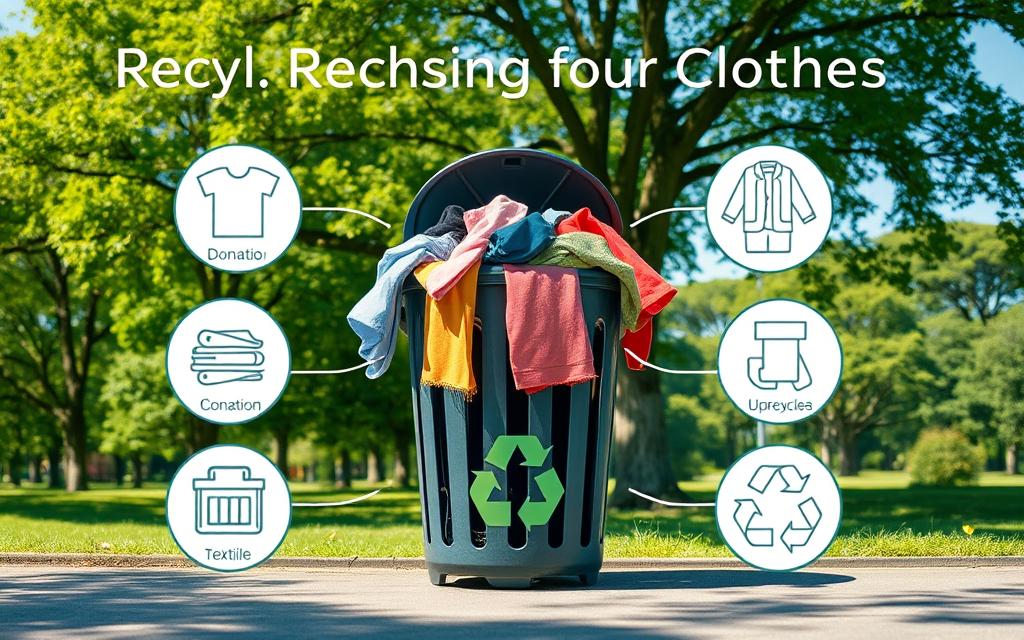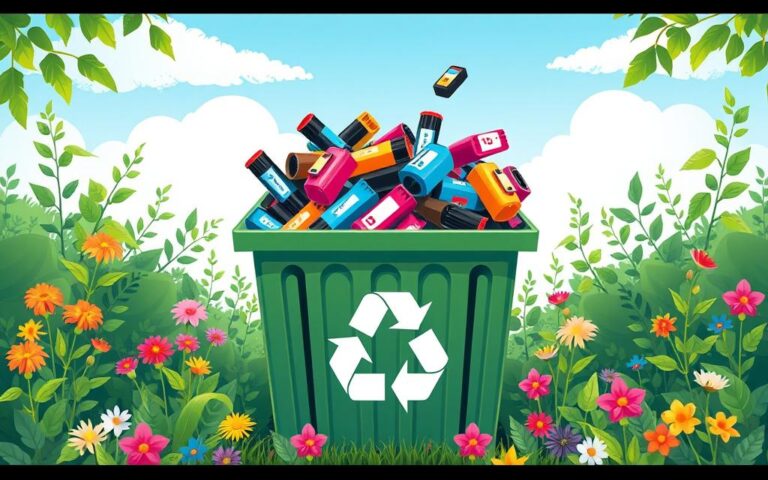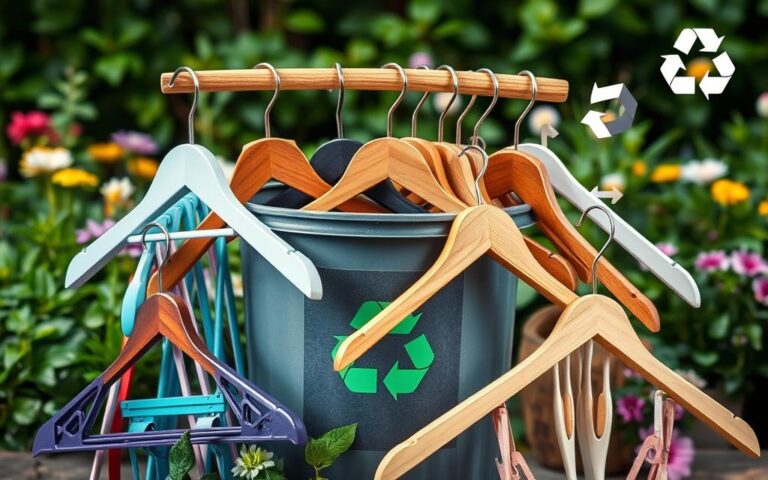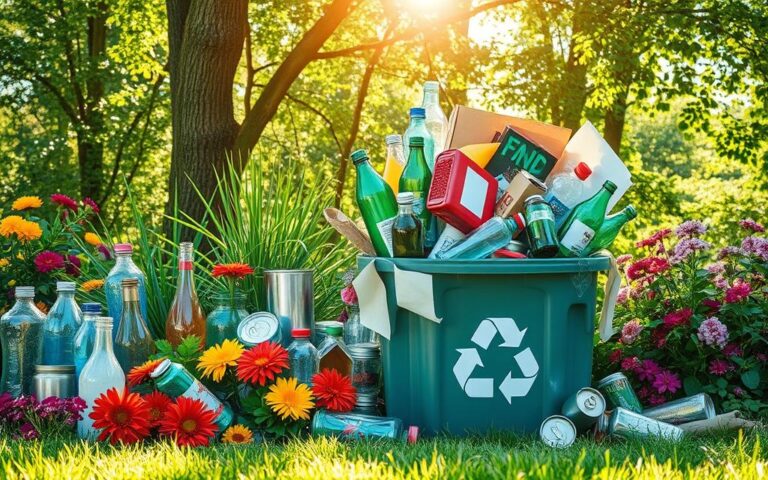Can You Put Clothes in the Recycle Bin? Disposal Options
Many of us wonder if you can put clothes in the recycle bin to help the environment. Sadly, regular recycling bins can’t take clothes. In 2018, the U.S. only recycled 14.7% of its textiles, creating 17 million tons of waste. This shows how vital correct disposal is for the earth.
It’s important to know about disposal options for clothes. Clothes can be hard to recycle because they’re made of different materials. Finding the right way to recycle clothes can reduce pollution and the greenhouse gases from textiles in landfills. More tips on recycling clothes can be found here.
We will look at how best to recycle clothes, clear up any wrong ideas, and talk about eco-friendly ways to dispose of them. These methods are good for our planet.
Understanding Recycling Basics
Knowing about recycling basics is crucial for good waste management. It’s very important to keep recycling clean. This makes sure the recycling process works well. For example, wrong items like clothes can cause problems at recycling centres. This leads to more costs and lower recycling success.
The Importance of Clean Recycling
It’s vital to keep recycling free from contaminants. Dirty items can mess up the sorting process. This stops us from getting back useful materials. Things like plastics, papers, and metals have their own recycling codes. These help us know how to dispose of them correctly. When people understand and follow these rules, recycling gets better and less dirty.
Common Misconceptions About Recycling
There are many wrong ideas about recycling. Some think everything can be recycled easily. This isn’t true for some items like certain plastics and clothes. It’s important to know these facts. This helps us recycle the right way. By correcting these myths, we all help make recycling more effective. This improves our communities’ sustainability.
Can You Put Clothes in the Recycle Bin?
Knowing how to dispose of textiles correctly is key to reducing waste. By adhering to recycling guidelines for clothes, the success of recycling programmes increases. Sadly, some still think tossing clothes in regular bins is okay, which complicates the system.
Recycling Guidelines for Textiles
Recycling programmes often exclude clothes due to their complex recycling process. To recycle textiles properly, one must follow certain rules:
- Ensure clothing is both clean and dry.
- Items must not have contaminants like electronic cords, which don’t recycle.
- Textiles usually need special facilities familiar with handling everything from garments to accessories.
Following these guidelines properly supports eco-friendly waste reduction.
What Happens to Clothes in the Recycle Bin?
Incorrectly placed clothes in recycling bins cause disruptions and contamination. Facilities like PennWaste see clothing clog machines, raising costs and downtime. Every year, 17 billion pounds of clothes improperly end up in landfills, harming environments and recycling plant operations.
It’s crucial to know that incorrect disposal can hinder recycling other materials. The right disposal practices enhance recycling and encourage environmental care.

Why Clothes Should Not Go in the Recycle Bin
Putting clothes in recycling bins might look like a small act. However, it greatly impacts recycling efforts and the environment. By understanding the contamination in recycling, we learn why textiles need careful handling.
Impact of Contamination on Recycling Programs
Textiles in recycling streams cause contamination. This makes recycling harder, especially with synthetic fibres. They’re hard to separate, raising waste management costs. The Environmental Protection Agency (EPA) noted that textiles make up 9% of general waste. With a truckload of textiles wasted each second, it’s vital to find other ways to dispose of them. Sadly, less than 1% of clothing materials are reused for new products.
Environmental Consequences of Improper Disposal
Incorrectly disposed of clothes lead to major environmental problems. In 2018, the U.S. threw away 14.5 million tons of textiles. This adds a lot to greenhouse gas emissions. Ireland’s per head consumption of new textiles is 53 kg a year. That highlights the need for better solutions. Charity shops and textile banks are good options. They lessen waste and its environmental impact. However, only a bit of donated clothes get sold again. If we don’t change, the planet will face more harm from clothes waste.
Eco-Friendly Alternatives to Throwing Away Clothes
Textile waste is growing, so we must find eco-friendly ways to dispose of clothes. Instead of throwing them in the bin, there are sustainable methods. These methods are good for the environment and local communities.
Donating Your Unwanted Garments
Donating clothes to charities reduces waste in landfills. Groups like Goodwill and the Salvation Army take garments in good condition. They help local communities and support recycling. But remember, not all donated clothes are sold. Many face uncertain futures. Still, donating gives clothes a new life and helps those in need.
Upcycling and Reselling Options
Turning old clothes into new items through upcycling is another great idea. It cuts down on waste. Websites like Poshmark help people sell upcycled clothes to a wide audience. Second-hand shopping is becoming more popular. It’s good for the environment and promotes sustainable living.
Brand Take-Back Programs
Some companies, like Nike and Patagonia, have started take-back programs. They take old clothes back for recycling or reselling. Joining these programs is an easy way to get rid of textiles responsibly. It stops them from adding to the environmental problems caused by textile waste.
| Option | Benefits | Examples |
|---|---|---|
| Donating Clothes | Supports local communities, reduces landfill waste | Goodwill, Salvation Army |
| Upcycling Textiles | Creative reuse, promotes sustainability | Personal projects, platforms like Poshmark |
| Brand Take-Back Initiatives | Responsible disposal, encourages recycling | Nike, Patagonia |
Choosing eco-friendly disposal methods makes a big difference in reducing textile waste. Each option helps us move towards a sustainable future.
How to Properly Dispose of Clothes
Donating clothes properly helps cut down on landfill waste and supports sustainability. Charities that take clothing use the money to help others and their communities. It’s important to know where to recycle textiles to stop them from harming the environment.
Local Charitable Organisations and Their Mission
Local charities help those in need with your donated clothes. They sell these donations in shops or give them directly to people. Organisations like Oxfam, British Red Cross, and others are examples.
- Oxfam
- British Red Cross
- Salvation Army
- Emmaus
Donating clothes means you’re helping both people and the planet. Your gently used items can make a big difference to someone and reduce waste.
Textile Recycling Facilities You Can Use
Textile recycling centres focus on reusing clothes, by sorting them into different types and conditions. This process makes sure that even worn-out clothes get recycled. You can find clothing recycle bins or services in many places.
| Recycling Company | Services Offered |
|---|---|
| Supercircle | Facilitates clothing collection and processing |
| EVRNU | Turns old textiles into new fibres |
| Patagonia | Has recycling bins and take-back schemes in stores |
| H&M | Runs clothing take-back and recycling projects |
Using textile recycling facilities lessens the negative effects of throwing away clothes. Always take clothes to the right recycling centres. By doing so, you help decrease pollution from making new textiles and save resources.
Other Ways to Give New Life to Old Clothes
Getting creative with repurposing old clothes helps cut down waste. It also promotes sustainability. There are many ways to do this, like composting textiles or sending second-hand clothes overseas.
Composting Natural Fibres
Composting is great for natural fibres such as cotton and wool. These fabrics break down in the soil and help it. This process keeps waste out of landfills and aids farming sustainability.
It’s vital to use clothes that don’t have synthetic blends. These don’t break down and can mess with the composting process.
Exportation Programs for Second-Hand Clothing
Exporting second-hand clothing is also beneficial. Many groups help send clothes to places where people need them. This provides affordable clothing and helps local economies too.
Clothes that might not be good enough for donation find new homes overseas. This is a sustainable way to extend the life of every garment.
| Method | Description | Environmental Benefit |
|---|---|---|
| Composting | Breaking down natural fibre textiles to enrich soil. | Reduces landfill waste and supports agriculture. |
| Exporting Second-Hand Clothing | Facilitating garment distribution to communities in need. | Minimises textile waste in developed countries. |
By using these methods, we can all help. We ensure old clothes find new uses. This way, we support sustainability and avoid simply throwing clothes away.
Conclusion
Addressing the issue of clothing disposal is key for sustainable textile practices. Every year, 30% of unwanted UK clothes end up in landfill. That’s around 300,000 tonnes thrown away. This shows how vital it is to recycle clothes and why it’s crucial for people to dispose of them responsibly.
We have discussed eco-friendly ways to deal with unwanted clothes. People can donate them or use textile recycling. These methods help keep materials out of landfills and support a sustainable, circular economy. It’s up to everyone to play their part in reducing environmental harm.
Adopting proper textile disposal methods greatly reduces waste and supports sustainability. As we continue, it’s important to stay dedicated to recycling and finding new uses for our clothes. This commitment helps safeguard our planet and its resources for the future.
FAQ
Can I put clothes in the recycle bin?
No, clothes should not be placed in standard recycling bins as they can disrupt the recycling process. Instead, consider donating them or using specialized textile recycling facilities.
What should I do with unwanted clothes?
You can donate your unwanted garments to local charities or upcycle them into new items. Look for brand take-back programmes offered by companies like Nike and Patagonia.
Why is proper disposal of clothes important?
Proper disposal is vital to avoid contamination in recycling streams. It prevents the hindrance of the recycling process. This also stops increased waste in landfills and helps address environmental issues.
How can I find textile recycling facilities?
To find textile recycling facilities, check local government resources. You can also visit websites of recycling organisations. Or contact charities that accept textiles.
What are the environmental consequences of throwing clothes away?
Throwing clothes away causes harm by emitting greenhouse gases from decomposing textiles. It also adds to the overall textile waste problem, negatively impacting our environment.
Can I compost clothing?
Yes, clothing made from natural fibres like cotton and wool can be composted. This is if they don’t contain synthetic materials. It reduces waste and enriches the soil.
What are the benefits of upcycling old clothes?
Upcycling reduces textile waste by transforming garments into new items. It encourages creativity. Plus, it often leads to unique, custom items, reducing landfill waste.















